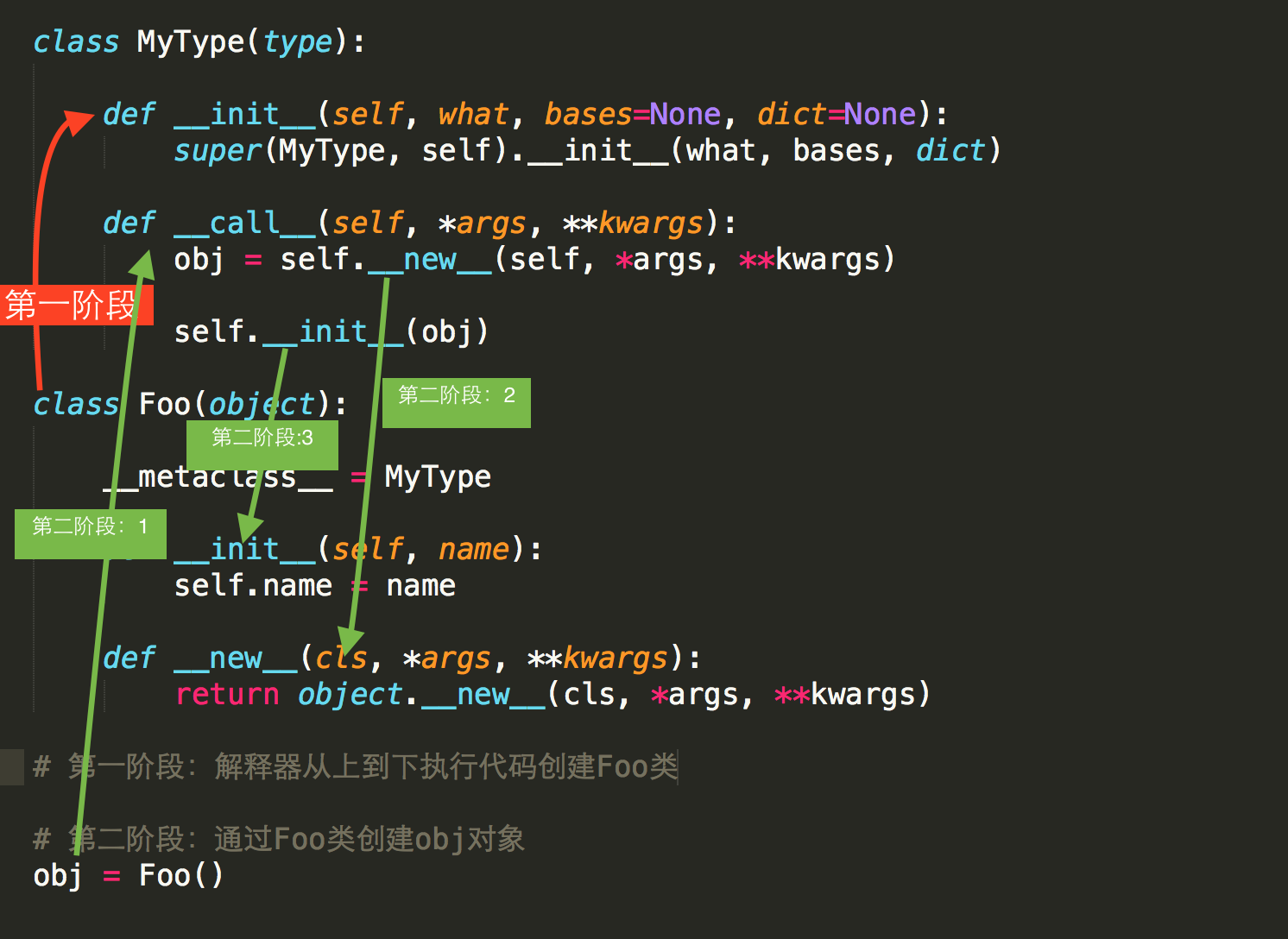title: Python学习记录day8
tags: python
author: Chinge Yang
date: 2017-02-27
Python学习记录day8
@(学习)[python]
1. 静态方法
@staticmethod装饰器即可把其装饰的方法变为一个静态方法。静态方法,只是名义上归类管理,实际上在静态方法里访问不了类或实例中的任何属性。
#!/usr/bin/env python
# _*_coding:utf-8_*_
'''
* Created on 2017/2/27 20:18.
* @author: Chinge_Yang.
'''
class Cat(object):
def __init__(self, name):
self.name = name
@staticmethod # 把eat方法变为静态方法
def eat(self):
print("%s is eating" % self.name)
d = Cat("bana")
d.eat()
上面的调用会出以下错误,说是eat需要一个self参数,但调用时却没有传递,没错,当eat变成静态方法后,再通过实例调用时就不会自动把实例本身当作一个参数传给self了。
staticmethod.py", line 19, in <module>
d.eat()
TypeError: eat() missing 1 required positional argument: 'self'
想让上面的代码可以正常工作有两种办法
- 调用时主动传递实例本身给eat方法,即d.eat(d)
- 在eat方法中去掉self参数,但这也意味着,在eat中不能通过self.调用实例中的其它变量了
#!/usr/bin/env python
# _*_coding:utf-8_*_
'''
* Created on 2017/2/27 20:18.
* @author: Chinge_Yang.
'''
class Cat(object):
def __init__(self, name):
self.name = name
@staticmethod # 把eat方法变为静态方法
def eat(): # 此处去掉self
print("is eating")
d = Cat("bana")
d.eat()
2. 类方法
类方法通过@classmethod装饰器实现,其只能访问类变量,不能访问实例变量。
#!/usr/bin/env python
# _*_coding:utf-8_*_
'''
* Created on 2017/2/27 20:18.
* @author: Chinge_Yang.
'''
class Cat(object):
name = "类变量" # 需要在类中定义变量
def __init__(self, name):
self.name = name
@classmethod # 把eat方法变为类方法
def eat(self): # 此处有self
print("%s is eating" % self.name)
d = Cat("bana")
d.eat()
结果:实例传入的参数不能被使用,使用的是类内部变量。因为没有在类中定义name的话,会有错误提示。
类变量 is eating
3. 属性方法
属性方法通过@property把一个方法变成一个静态属性。
#!/usr/bin/env python
# _*_coding:utf-8_*_
'''
* Created on 2017/2/27 20:18.
* @author: Chinge_Yang.
'''
class Cat(object):
def __init__(self, name):
self.name = name
@property # 把eat方法变为属性方法
def eat(self):
print("%s is eating" % self.name)
d = Cat("bana")
d.eat # 此处不加括号
把一个方法变成静态属性有什么应用场景呢?
比如 ,你想知道一个航班当前的状态,是到达了、延迟了、取消了、还是已经飞走了, 想知道这种状态你必须经历以下几步:
- 连接航空公司API查询
- 对查询结果进行解析
- 返回结果给你的用户
因此这个status属性的值是一系列动作后才得到的结果,所以你每次调用时,其实它都要经过一系列的动作才返回你结果,但这些动作过程不需要用户关心, 用户只需要调用这个属性就可以。
class Flight(object):
def __init__(self,name):
self.flight_name = name
def checking_status(self):
print("checking flight %s status " % self.flight_name)
return 1
@property
def flight_status(self):
status = self.checking_status()
if status == 0 :
print("flight got canceled...")
elif status == 1 :
print("flight is arrived...")
elif status == 2:
print("flight has departured already...")
else:
print("cannot confirm the flight status...,please check later")
f = Flight("CA980")
f.flight_status
既然这个flight_status已经是个属性了, 那给它赋值又如何使用呢?
需要通过@proerty.setter装饰器再装饰一下,此时 你需要写一个新方法, 对这个flight_status进行更改。
class Flight(object):
def __init__(self,name):
self.flight_name = name
def checking_status(self):
print("checking flight %s status " % self.flight_name)
return 1
@property
def flight_status(self):
status = self.checking_status()
if status == 0 :
print("flight got canceled...")
elif status == 1 :
print("flight is arrived...")
elif status == 2:
print("flight has departured already...")
else:
print("cannot confirm the flight status...,please check later")
@flight_status.setter #修改
def flight_status(self,status):
status_dic = {
0 : "canceled",
1 :"arrived",
2 : "departured"
}
print("�33[31;1mHas changed the flight status to �33[0m",status_dic.get(status) )
@flight_status.deleter #删除
def flight_status(self):
print("status got removed...")
f = Flight("CA980")
f.flight_status
f.flight_status = 2 #触发@flight_status.setter
del f.flight_status #触发@flight_status.deleter
注意以上代码里还写了一个@flight_status.deleter, 是允许可以将这个属性删除。
4. 类的特殊成员方法
4.1 __doc__表示类的描述信息
class Foo:
""" 描述类信息 """
def func(self):
pass
print(Foo.__doc__)
结果:
描述类信息
4.2 __module__ 和 __class__
__module__表示当前操作的对象在那个模块
__class__表示当前操作的对象的类是什么
cat lib/c.py
class Foo(object):
def __init__(self):
self.name = 'ygqygq2'
cat index.py
from lib.c import Foo
obj = Foo()
print(obj.__module__) # 输出 lib.c,即:输出模块
print(obj.__class__) # 输出 <class 'lib.c.Foo'>,即:输出类
4.3 __init__ 构造方法
__init__ 构造方法通过类创建对象时,自动触发执行。
4.4 __del__ 析构方法
析构方法,当对象在内存中被释放时,自动触发执行。
注:此方法一般无须定义,因为Python是一门高级语言,程序员在使用时无需关心内存的分配和释放,因为此工作都是交给Python解释器来执行,所以,析构函数的调用是由解释器在进行垃圾回收时自动触发执行的
4.5 __call__ call方法
对象后面加括号,触发执行。
class Foo(object):
def __init__(self):
pass
def __call__(self, *args, **kwargs):
print('__call__')
obj = Foo() # 执行 __init__
obj() # 执行 __call__
注:构造方法的执行是由创建对象触发的,即:对象 = 类名() ;而对于 __call__ 方法的执行是由对象后加括号触发的,即:对象() 或者 类()()
4.6 __dict__
__dict__ 查看类或对象中的所有成员
class Province(object):
country = 'China'
def __init__(self, name, count):
self.name = name
self.count = count
def func(self, *args, **kwargs):
print('func')
# 获取类的成员,即:静态字段、方法、
print(Province.__dict__)
# 输出:{'__init__': <function Province.__init__ at 0x106a210d0>, 'country': 'China', 'func': <function Province.func at 0x106a21488>, '__doc__': None, '__dict__': <attribute '__dict__' of 'Province' objects>, '__module__': '__main__', '__weakref__': <attribute '__weakref__' of 'Province' objects>}
obj1 = Province('HeBei',10000)
print (obj1.__dict__)
# 获取 对象obj1 的成员
# 输出:{'count': 10000, 'name': 'HeBei'}
obj2 = Province('HeNan', 3888)
print(obj2.__dict__)
# 获取 对象obj1 的成员
# 输出:{'count': 3888, 'name': 'HeNan'}
4.7 __str__ 方法
如果一个类中定义了__str__方法,那么在打印 对象 时,默认输出该方法的返回值。
class Foo(object):
def __str__(self):
return 'ygqygq2'
obj = Foo()
print(obj)
# 输出:ygqygq2
4.8 __getitem__、__setitem__、__delitem__
用于索引操作,如字典。以上分别表示获取、设置、删除数据。
class Foo(object):
def __getitem__(self, key):
print('__getitem__', key)
def __setitem__(self, key, value):
print('__setitem__', key, value)
def __delitem__(self, key):
print('__delitem__', key)
obj = Foo()
result = obj['k1'] # 自动触发执行 __getitem__
obj['k2'] = 'ygqygq2' # 自动触发执行 __setitem__
del obj['k1']
结果:
__getitem__ k1
__setitem__ k2 ygqygq2
__delitem__ k1
4.9 __new__ __metaclass__
class Foo(object):
def __init__(self,name):
self.name = name
f = Foo("ygqygq2")
print(type(Foo))
print(type(f))
结果:
<class 'type'>
<class '__main__.Foo'>
上述代码中,obj 是通过 Foo 类实例化的对象,其实,不仅 obj 是一个对象,Foo类本身也是一个对象,因为在Python中一切事物都是对象。
如果按照一切事物都是对象的理论:obj对象是通过执行Foo类的构造方法创建,那么Foo类对象应该也是通过执行某个类的 构造方法 创建。
print type(f) # 输出:<class 'main.Foo'> 表示,obj 对象由Foo类创建
print type(Foo) # 输出:<class 'type'> 表示,Foo类对象由 type 类创建
所以,f对象是Foo类的一个实例,Foo类对象是 type 类的一个实例,即:Foo类对象 是通过type类的构造方法创建。
那么,创建类就可以有两种方式:
1). 普通方式
class Foo(object):
def func(self):
print('hello')
2). 特殊方式
def func(self):
print('hello')
Foo = type('Foo',(object,), {'func': func})
#type第一个参数:类名
#type第二个参数:当前类的基类
#type第三个参数:类的成员
加上构造方法,所以 ,类是由 type 类实例化产生。
那么问题来了,类默认是由 type 类实例化产生,type类中如何实现的创建类?类又是如何创建对象?
答:类中有一个属性 __metaclass__,其用来表示该类由谁来实例化创建,所以,我们可以为 __metaclass__ 设置一个type类的派生类,从而查看类 创建的过程。

类的生成 调用 顺序依次是 __new__ --> __call__ --> __init__